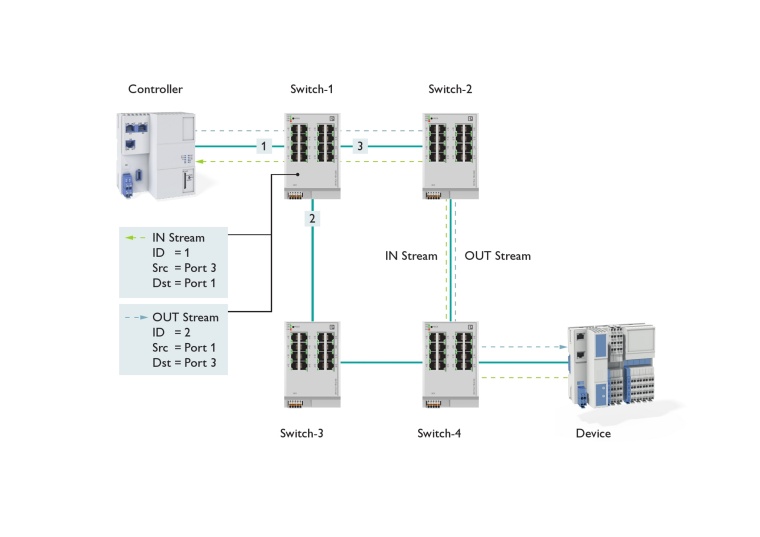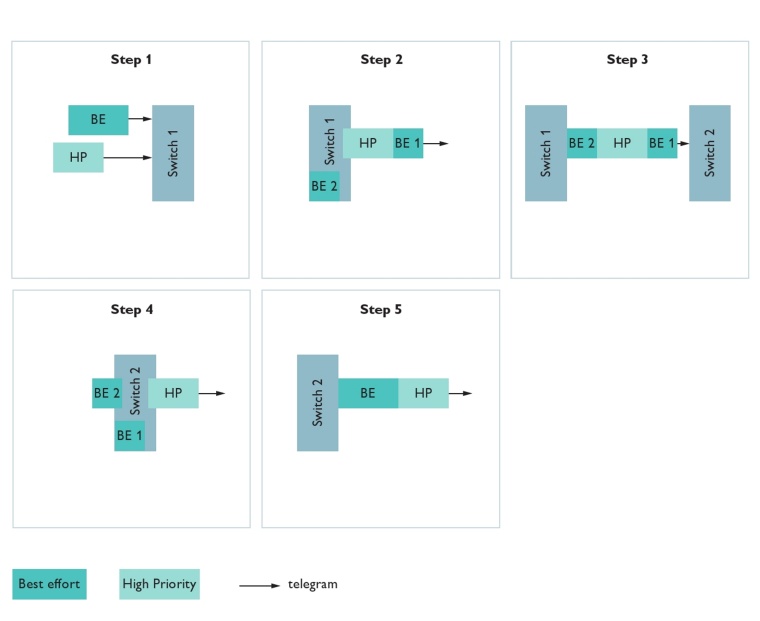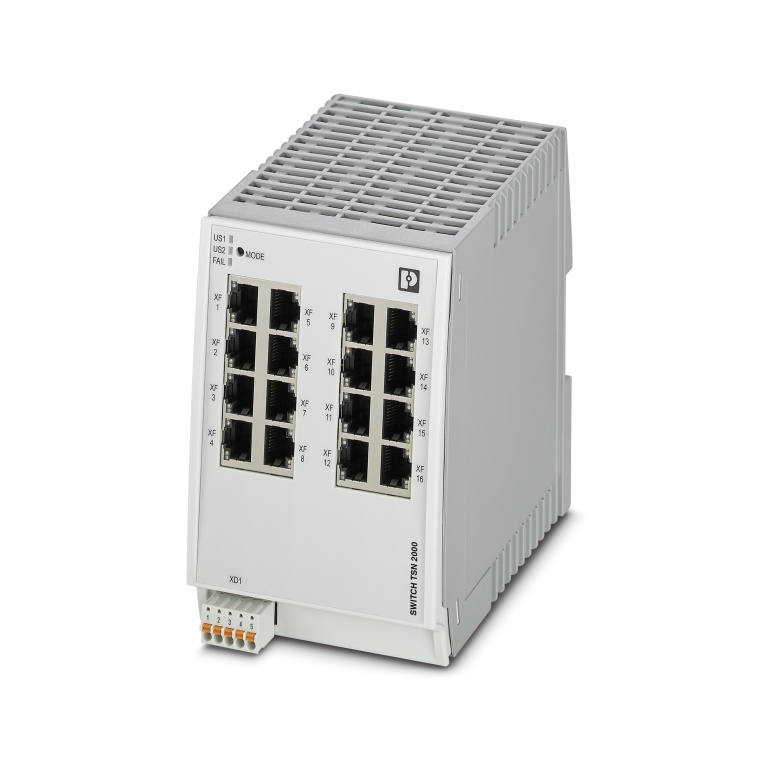Ethernet Switches for TSN
As a result of the standardization activities of the Industrial Automation Profile IEC/IEEE 60802, the convergent TSN network will be able to be used by further industrial applications in addition to Profinet via TSN. A new Ethernet switch supports all required TSN mechanisms of this Industrial Automation Profile on the hardware side. Therefore, based on an extended configuration, convergent use with OPC UA and further protocols is given in the future.
The trend toward digitization is leading to growing communication requirements at the OT (operational technology) level. At the same time, OT is to be optimally and consistently integrated into corporate IT. One of the new requirements is that many parallel services, which must not interfere with each other, must be available reliably and robustly. For example, smart sensors should, on the one hand, transmit their actual values - such as position or speed - in real time to the local controller, which uses them for highly dynamic control. On the other hand, the detailed raw sensor data must be transmitted to higher-level IT systems or a cloud, where it can be analyzed and then used for process optimization or predictive maintenance. The service employee must be able to access intelligent field devices remotely during operation and visually inspect the working mold or workpiece in parallel via high-resolution camera images.



All in all, this means higher bandwidth requirements for the network. In addition, it must be ensured that the various services are served according to their real-time requirements. The TSN standards in IEEE 802.1 and the IEC 60802 industrial automation profile based on them play a key role here: they enable the coexistence of real-time-critical data exchange and standard IT communication in a convergent network.
Retaining proven field devices through suitable migration concepts
However, industrial users are faced with the challenge that current automation standards contain structures that have grown over the years, as well as a large number of different devices in use. Proven field devices that do not currently support TSN should still be able to be used. Therefore, suitable migration concepts are required that ensure investment protection through the reuse of established hardware as well as software that has been developed over many years. In addition, entry into TSN technology is desirable in order to benefit from the resulting user advantages. The appropriate industrial switches act as essential components for a migration strategy towards a TSN network.
With the new FL Switch TSN 2300 from Phoenix Contact, Ethernet switches for Time Sensitive Networking (TSN) are available that allow such migration concepts for Profinet and TSN. Profinet via Time Sensitive Networking is available with specification 2.4. The basic approach is to offer another option on layer 2 in addition to Profinet RT and IRT with TSN, which enables higher bandwidths, deterministics as well as flexible network configurations. Since the higher-level user interfaces are also available unchanged with Profinet via TSN, I/O data, diagnostics and parameterization can be used in the proven manner. This opens up optimal migration paths for both the device manufacturer and the user.
Communicating in real time through prioritization and frame preemption
To meet increasing communication requirements, the FL Switch TSN 2300 includes 16 ports in Gigabit performance, all of which are TSN-capable. For Profinet operation over TSN, the switches provide precise IEEE 802.1AS time synchronization, frame preemption, and stream management over Profinet. Due to the IEEE 802.1AS time synchronization, all connected components in the network operate on the same highly accurate time basis, which allows time-synchronous applications and forms the basis for the other TSN mechanisms.
Through strict prioritization and frame preemption, the switches ensure that time-critical data is transmitted in real time in every case - in the case of Profinet, via the so-called real-time streams. If critical real-time data is to be forwarded at an exact time and the output port of the switch is still occupied due to the transmission of a low-priority frame, this communication is simply interrupted and only continued afterwards. On the receiving side, i.e. the neighboring switch, the interrupted frame is then assembled and transmitted. Because the frame preemption mechanism is implemented automatically by the two switches involved, no additional configuration is required. Furthermore, the bandwidth of this backbone connection (switch-switch) can be optimally utilized, since no time-based reservation of bandwidth needs to take place.
Flexible construction of mixed topologies from existing and TSN-capable devices
In addition, the new TSN switches include the same comprehensive feature set known from the other managed switches from Phoenix Contact. Thus, the TSN switches can also be used universally in classic applications. In the Profinet version, the devices support all functions defined for Conformance Class B apart from TSN. In this way, an existing Profinet RT application can be operated in parallel by the switches and integrated into the TSN network. This makes it possible to implement mixed topologies that connect existing devices or device classes without any changes and without high real-time requirements. Consequently, the machine manufacturer can use the real-time properties of TSN for highly dynamic control loops, for example, while other areas are connected in the classic way. And the plant operator migrates his grown network structure successively to a convergent TSN network. However, industrial TSN switches already offer advantages in applications where only established protocols are used. Based on prioritization, classic switches can arrange incoming frames in corresponding outgoing queues and process them in a priority-controlled manner. The limits of TSN technology lie in a potentially busy output port, which just outputs a possibly larger Ethernet data frame. In this case, a high-priority transmission can only be forwarded with a delay. The extent to which this is tolerable depends on the frequency, network load and maximum packet length. Applications in which large packets are often forwarded - for example, the transmission of camera raw data over jumbo frames up to 10,000 bytes long - prove to be particularly critical. This scenario can be solved with the TSN function Frame Preemption: Both applications, which previously required two separate networks to be installed, are now operated in parallel in one network. In TSN networks, real-time-critical communication takes place via so-called real-time streams. Depending on the real-time requirements and prioritization of the respective data packet, certain quality-of-service properties (bandwidth, latency, etc.) are assigned to them.
Setting TSN network parameters
Streams operate unidirectionally from the talker to the listener, so streams are established between the controller and the devices for both directions. These must be reserved in the network and switches before deployment so that the available bandwidth can be checked in relation to other streams.
TSN networks therefore require configuration in any case. The ease of setting the required TSN network parameters is shown to be crucial for user acceptance. To simplify and standardize TSN configuration, the concept of a Network Management Engine (NME) has been implemented. This function is usually located in the Profinet controller, but can also be implemented separately. The handling of the familiar engineering tools remains the same. However, planning is made much easier because the creation of a network configuration in TSN does not take place offline in engineering, but at runtime of the NME, for example by making the settings as part of the runtime function of the controller. The Network Management Engine reads the topology of the network at runtime, calculates the real-time streams as well as their paths, and configures the switches in the network accordingly. If the topology changes due to newly added or replugged devices, the NME adjusts the stream settings analogously at runtime. The user gets a user-friendly TSN configuration via Profinet 2.4 engineering. This makes setting up isochromic traffic as easy as with classic Profinet RT.
Author
Uwe Nolte, Manager Product Marketing Network Technology
Company
Phoenix Contact GmbH & Co.KGFlachsmarktstr. 8
32825 Blomberg
Germany
most read

There’s a Large Hippo Resting in the Mud
Virtual Video Safaris for Blind and Visually Impaired People

SPS 2025: Cautious optimism in automation
A picture of the mood of the German economy







